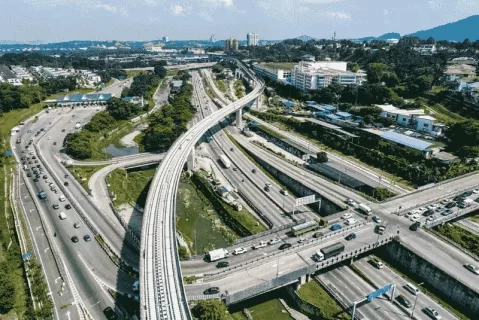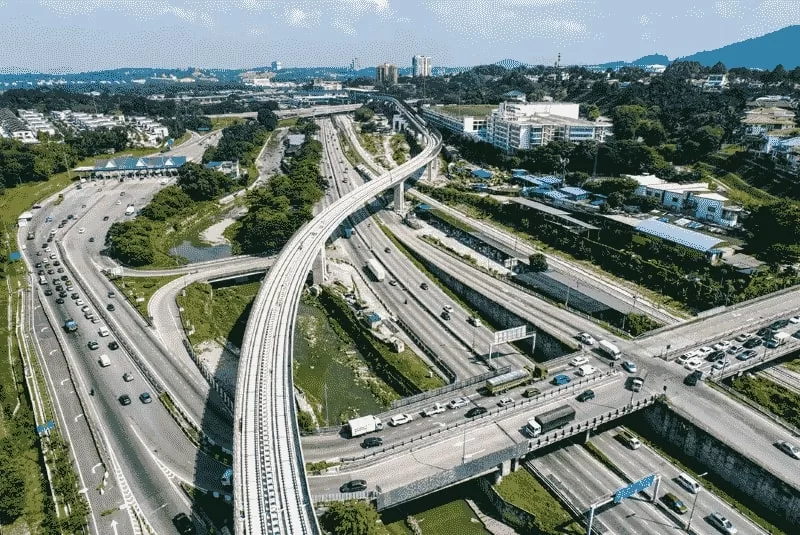The North-South Expressway (NSE), otherwise known as PLUS Expressway, derived from Projek Lebuhraya Utara Selatan, is the longest in Malaysia. Its 772-kilometer or 480-mile stretches from Bukit Kayu Hitam, in Kubang Pasu District, Kedah, near the border of Malaysia and Thailand in the north, to Johor Bahru at the southern end of the Malaysian Peninsula in the south.
This major road was completed and inaugurated in 1994 under the regime of the then-Malaysian Prime Minister, Tun Dr. Mahathir bin Mohamad. The construction of all the phases took seven years to finish.
Significance of Johor North-South Expressway (NSE)

Johor North-South Expressway (Photo credits: https://www.klia2.info/trips/highways/plus-expressway-north-south-expressway/)
Just like the Singapore-Malaysia RTS Link Project and Kuala Lumpur’s Lorong Kuda Tunnel, the NSE is also a crucial link in Malaysian transportation. It connects key cities in Malaysia and serves as a major entry and exit point to and from the country. It is the main access road to and from the major market centers of Alor Setar, Ipoh, Melaka, Penang, Seremban, and Johor Bahru.
Additionally, it connects the borders of Singapore and Thailand and passes through seven states, namely Johor, Malacca, Negeri Sembilan, Selangor, Perak, Penang, and Kedah. It also serves as a quick alternative road for travelers heading to the old Federal Route 1, which used to be the main road of the western part of the country or Peninsular Malaysia.
NSE Expansion Project Underway
The North-South Expressway is currently going through expansion, increasing its lanes from four to six. As of the moment, only the stretch of road between Kuala Lumpur and Melaka has six to eight lanes.
This expansion aims to ease traffic flow, not only to make more room for the ever-increasing number of vehicles utilizing the highway but also to ease traffic management through control and surveillance. The Malaysian Highway Authority also aims to eventually address the scheduling of heavy vehicles’ journeys, which may be diverted to other federal roads to decongest traffic in NSE.

The Plus Highway Network (Photo credits: https://www.klia2.info/trips/highways/plus-expressway-north-south-expressway/)
Phase 1
This phase consists of widening the 21.8 km stretch of road between Senai Utara and Sedenak (Package A). WCT Holdings Berhad (WCT) was awarded this contract worth RM249.74 million, which requires the construction of additional lanes between Yong Peng and Senai.
The construction began on 28 June 2024 and is projected to be completed within 36 months. The scope of work includes the following:
- bridge structures
- demolition works
- drainage works
- earthworks
- environmental protection works
- extension of vehicular box culvert
- geotechnical works
- pavement works
- relocation of utilities
- road furniture
- road lighting system
- road markings
- site clearance
Phase 2
Phased 2 focuses on widening the road between Sedenak and Machap and is set to begin in early 2025.
Phase 3
This phase is still in its planning stage and targets to extend the 41km road from Simpang Renggam to Yong Peng Utara by 2025. The government has yet to set a budget for this section of the project, but it was projected to be around RM1 billion.
Challenges of the PLUS Expressway Lane Expansion Project
Many consider this expansion project challenging because of its hilly and steep terrain. This makes it particularly more burdensome for heavy vehicles, especially on the third lane.
Despite the concerns, Chairman Datuk Seri Hasni Mohammad of the Malaysian Highway Authority assured the public that the existing lanes will remain open despite the expansion works.
Factsheet
Owner/Operator: Projek Lebuhraya Utara Selatan/PLUS Expressways
Project Name: PLUS Expressway Lane Expansion Project
Project Type: Highway Expansion Project
Project Scope: Construction of additional lanes in Johor
Location: Johor, from Sedenak to Simpang Renggam
Contractor (EPC): WCT Holdings Berhad (Phase 1)
Phase 1 Value: RM249.74 million (US $57.1 million)
Total Value: RM931 million (US $213 million)
Construction Start: June 28, 2024
Construction End: After 36 months from commencement (Phase 1)

